Enhancement of the Conductivity and Uniformity of Silver Nanowire Flexible Transparent Conductive Films by Femtosecond Laser-Induced Nanowelding
Abstract
1. Introduction
2. Material and Methods
2.1. Material and Film Coating
2.2. Laser Welding AgNW FTCFs
2.3. Performance Characterization
3. Results and Discussion
3.1. Morphology of the Laser-Welded AgNWs
3.2. Numerical Analysis of the Electric Field Intensity for Laser-Welded the AgNWs
3.3. Sheet Resistance and Transmittance
3.4. Distribution of Sheet Resistance of the AgNW FTCFs
3.5. Reliability of the AgNW FTCFs
4. Conclusions
Author Contributions
Funding
Acknowledgments
Conflicts of Interest
References
- Ye, S.; Rathmell, A.R.; Chen, Z.; Stewart, I.E.; Wiley, B.J. Metal nanowire networks: The next generation of transparent conductors. Adv. Mater. 2014, 26, 6670–6687. [Google Scholar] [CrossRef]
- Ji, S.; He, W.; Wang, K.; Ran, Y.; Ye, C. Thermal response of transparent silver nanowire/PEDOT: PSS film heaters. Small 2014, 10, 4951–4960. [Google Scholar] [CrossRef] [PubMed]
- Huang, P.S.; Gao, T. Current development of 1D and 2D metallic nanomaterials for the application of transparent conductors in solar cells: Fabrication and modeling. Nano Struct. Nano Objects 2018, 15, 119–139. [Google Scholar] [CrossRef]
- Wang, J.; Liang, M.; Fang, Y.; Qiu, T.; Zhang, J.; Zhi, L. Rod-coating: Towards large-area fabrication of uniform reduced graphene oxide films for flexible touch screens. Adv. Mater. 2012, 4, 2874–2878. [Google Scholar] [CrossRef] [PubMed]
- Yu, H.K.; Kim, S.; Koo, B.; Jung, G.H.; Lee, B.; Ham, J.; Lee, J.L. Nano-branched transparent conducting oxides: Beyond the brittleness limit for flexible electrode applications. Nanoscale 2012, 4, 6831–6834. [Google Scholar] [CrossRef]
- Taesoon, P.; Jeonghong, H.; Dongsik, K. Laser processing of indium tin oxide thin film to enhance electrical conductivity and flexibility. Thin Solid Films 2018, 658, 38–45. [Google Scholar]
- Tenent, R.C.; Barnes, T.M.; Bergeson, J.D.; Ferguson, A.J.; To, B.; Gedvilas, L.M.; Heben, M.J.; Blackburn, J.L. Ultrasmooth, large-area, high-uniformity, conductive transparent single-walled-carbon-nanotube films for photovoltaics produced by ultrasonic spraying. Adv. Mater. 2009, 21, 3210–3216. [Google Scholar] [CrossRef]
- Pang, S.; Hernandez, Y.; Feng, X.; Mullen, K. Graphene as transparent electrode material for organic electronics. Adv. Mater. 2011, 23, 2779–2795. [Google Scholar] [CrossRef]
- Hongru, M.; Jinfeng, Z.; Steven, H.; Lei, M.; Mingze, M.; Xuhong, G.; Yanqing, M. Hydrothermal fabrication of silver nanowires-silver nanoparticles-graphene nanosheets composites in enhancing electrical conductive performance of electrically conductive adhesives. Nanomaterials 2016, 6, 119. [Google Scholar]
- Hauger, T.C.; Al-Rafia, S.M.; Buriak, J.M. Rolling silver nanowire electrodes: Simultaneously addressing adhesion, roughness, and conductivity. ACS Appl. Mater. Interfaces 2013, 5, 12663–12671. [Google Scholar] [CrossRef]
- Jia, Y.; Chen, C.; Jia, D.; Li, S.; Ji, S.; Ye, C. Silver nanowire transparent conductive films with high uniformity fabricated via a dynamic heating method. ACS Appl. Mater. Interfaces 2016, 8, 9865–9871. [Google Scholar] [CrossRef]
- Madaria, A.R.; Kumar, A.; Ishikawa, F.N.; Zhou, C. Uniform, highly conductive, and patterned transparent films of a percolating silver nanowire network on rigid and flexible substrates using a dry transfer technique. Nano Res. 2010, 3, 564–573. [Google Scholar] [CrossRef]
- Tokuno, T.; Nogi, M.; Karakawa, M.; Jiu, J.; Nge, T.T.; Aso, Y.; Suganuma, K. Fabrication of silver nanowire transparent electrodes at room temperature. Nano Res. 2011, 4, 1215–1222. [Google Scholar] [CrossRef]
- Park, J.H.; Hwang, G.T.; Kim, S.; Seo, J.; Park, H.J.; Yu, K.; Kim, T.S.; Lee, K.J. Flash-induced self-limited plasmonic welding of silver nanowire network for transparent flexible energy harvester. Adv. Mater. 2017, 29, 1603473. [Google Scholar] [CrossRef] [PubMed]
- Garnett, E.; Cai, W.; Cha, J.J.; Mahmood, F.; Connor, S.T.; Connor, M.G.; Christoforo, M.G.; Cui, Y.; McGehee, M.D.; Brongersma, M.L. Self-limited plasmonic welding of silver nanowire-junctions. Nat. Mater. 2012, 11, 241–249. [Google Scholar] [CrossRef]
- Kang, H.; Kim, Y.; Cheon, S.; Yi, G.R.; Cho, J.H. Halide welding for silver nanowire network electrode. ACS Appl. Mater. Interfaces 2017, 9, 30779–30785. [Google Scholar] [CrossRef] [PubMed]
- Peng, P.; Hu, A.; Gerlich, A.P.; Zou, G.; Liu, L.; Zhou, Y.N. Joining of silver nanomaterials at low temperatures: Processes, properties, and applications. ACS Appl. Mater. Interfaces 2015, 7, 12597–12618. [Google Scholar] [CrossRef] [PubMed]
- Liu, L.; Peng, P.; Hu, A.; Zou, G.; Duley, W.W.; Zhou, Y.N. Highly localized heat generation by femtosecond laser induced plasmon excitation in Ag nanowires. Appl. Phys. Lett. 2013, 102, 073107. [Google Scholar] [CrossRef]
- Spechler, J.A.; Nagamatsu, K.A.; Sturm, J.C.; Arnold, C.B. Improved efficiency of hybrid organic photovoltaics by pulsed laser sintering of silver nanowire network transparent electrode. ACS Appl. Mater. Interfaces 2015, 7, 10556–10562. [Google Scholar] [CrossRef]
- Shanliangzi, L.; Michelle, Y.; Lewis, W.E.; William, B.J.; Biwei, D.; Cheng, G.J.; Kramer, R. Laser sintering of liquid metal nanoparticles for scalable manufacturing of soft and flexible electronics. ACS Appl. Mater. Interfaces 2018, 10, 28232–28241. [Google Scholar]
- Torrisi, V.; Censabella, M.; Piccitto, G.; Grimaldi, M.; Ruffino, F. Characteristics of Pd and Pt nanoparticles produced by nanosecond laser irradiations of thin films deposited on topographically-structured transparent conductive oxides. Coatings 2019, 9, 68. [Google Scholar] [CrossRef]
- Spechler, J.A.; Arnold, C.B. Direct-write pulsed laser processed silver nanowire networks for transparent conducting electrodes. Appl. Phys. A 2012, 108, 25–28. [Google Scholar] [CrossRef]
- Ha, J.; Lee, B.J.; Hwang, D.J.; Kim, D. Femtosecond laser nanowelding of silver nanowires for transparent conductive electrodes. RSC Adv. 2016, 6, 86232–86239. [Google Scholar] [CrossRef]
- Cao, X.; Chen, Q.; Fan, H.; Zhang, L.; Juodkazis, S.; Sun, H. Liquid-assisted femtosecond laser precision-machining of silica. Nanomaterials 2018, 8, 287. [Google Scholar] [CrossRef] [PubMed]
- Hu, Y.; Yue, H.; Duan, J.A.; Wang, C.; Zhou, J.; Lu, Y.; Yin, K.; Dong, X.; Su, W.; Sun, S. Experimental research of laser-induced periodic surface structures in a typical liquid by a femtosecond laser. Chin. Opt. Lett. 2017, 15, 021404–021408. [Google Scholar]
- Chu, D.; Sun, X.; Dong, X.; Yin, K.; Luo, Z.; Chen, G.; Duan, J.A.; Hu, Y.; Zhao, X. Effect of double-pulse-laser polarization and time delay on laser-assisted etching of fused silica. J. Phys. D Appl. Phys. 2017, 50, 465306. [Google Scholar] [CrossRef]
- Ha, J.; Jung, H.Y.; Hao, J.; Li, B.; Raeliarijaona, A.; Alarcon, J.; Terrones, H.; Ajayan, P.M.; Jung, Y.J.; Kim, J.; et al. Ultrafast structural evolution and formation of linear carbon chains in single-walled carbon nanotube networks by femtosecond laser irradiation. Nanoscale 2017, 9, 16627–16631. [Google Scholar] [CrossRef] [PubMed]
- Sundaram, S.K.; Mazur, E. Inducing and probing non-thermal transitions in semiconductors using femtosecond laser pulses. Nat. Mater. 2002, 1, 217. [Google Scholar] [CrossRef]
- Gattass, R.R.; Mazur, E. Femtosecond laser micromachining in transparent materials. Nat. Photonics 2008, 2, 219–225. [Google Scholar] [CrossRef]
- Huang, H.; Sivayoganathan, M.; Duley, W.W.; Zhou, Y. High integrity interconnection of silver submicron/nanoparticles on silicon wafer by femtosecond laser irradiation. Nanotechnology 2015, 26, 025303. [Google Scholar] [CrossRef]
- Lin, L.; Liu, L.; Peng, P.; Zou, G.; Duley, W.W.; Zhou, Y.N. In situ nanojoining of Y- and T-shaped silver nanowires structures using femtosecond laser radiation. Nanotechnology 2016, 27, 125201. [Google Scholar] [CrossRef]
- Karim, S.; Toimil-Molares, M.E.; Balogh, A.G.; Ensinger, W.; Cornelius, T.W.; Khan, E.U.; Neumann, R. Morphological evolution of Au nanowires controlled by rayleigh instability. Nanotechnology 2006, 17, 5954–5959. [Google Scholar] [CrossRef]
- Rossouw, D.; Botton, G.A. Resonant optical excitations in complementary plasmonic nanostructures. Optics Express 2012, 20, 6968. [Google Scholar] [CrossRef]
- Taejoon, K.I.; Ki-Seok, J.; Wonjun, C.; Yonghoon, L. Creating well-defined hot spots for surface-enhanced raman scattering by single-crystalline noble metal nanowire pairs. J. Phys. Chem. C 2009, 113, 7492–7496. [Google Scholar]
- Han, S.; Hong, S.; Ham, J.; Yeo, J.; Lee, J.; Kang, B.; Lee, P.; Kwon, J.; Lee, S.S.; Yang, M.Y.; et al. Fast plasmonic laser nanowelding for a Cu-nanowire percolation network for flexible transparent conductors and stretchable electronics. Adv. Mater. 2014, 26, 5808–5814. [Google Scholar] [CrossRef]
- Hu, L.; Han, S.K.; Lee, J.Y.; Peumans, P.; Cui, Y. Scalable coating and properties of transparent, flexible, silver nanowire electrodes. ACS Nano 2010, 4, 2955–2963. [Google Scholar] [CrossRef]
- Fujita, Y.; Walke, P.; Lu, G.; Chamtouri, M.; De, S.; Uji-I, H. Surface plasmon-assisted site-specific cutting of silver nanowires using femtosecond laser. Adv. Mater. Technol. 2016, 1, 160014–160020. [Google Scholar] [CrossRef]
- Back, S.; Kang, B. Low-cost optical fabrication of flexible copper electrode via laser-induced reductive sintering and adhesive transfer. Opt. Lasers Eng. 2018, 101, 78–84. [Google Scholar] [CrossRef]
- Xie, F.; Lofgren, E.A.; Jabarin, S.A. Melting and crystallization behavior of poly(ethylene terephthalate) and poly(m-xylylene adipamide) blends. J. Appl. Polym. Sci. 2010, 118, 2153–2164. [Google Scholar] [CrossRef]
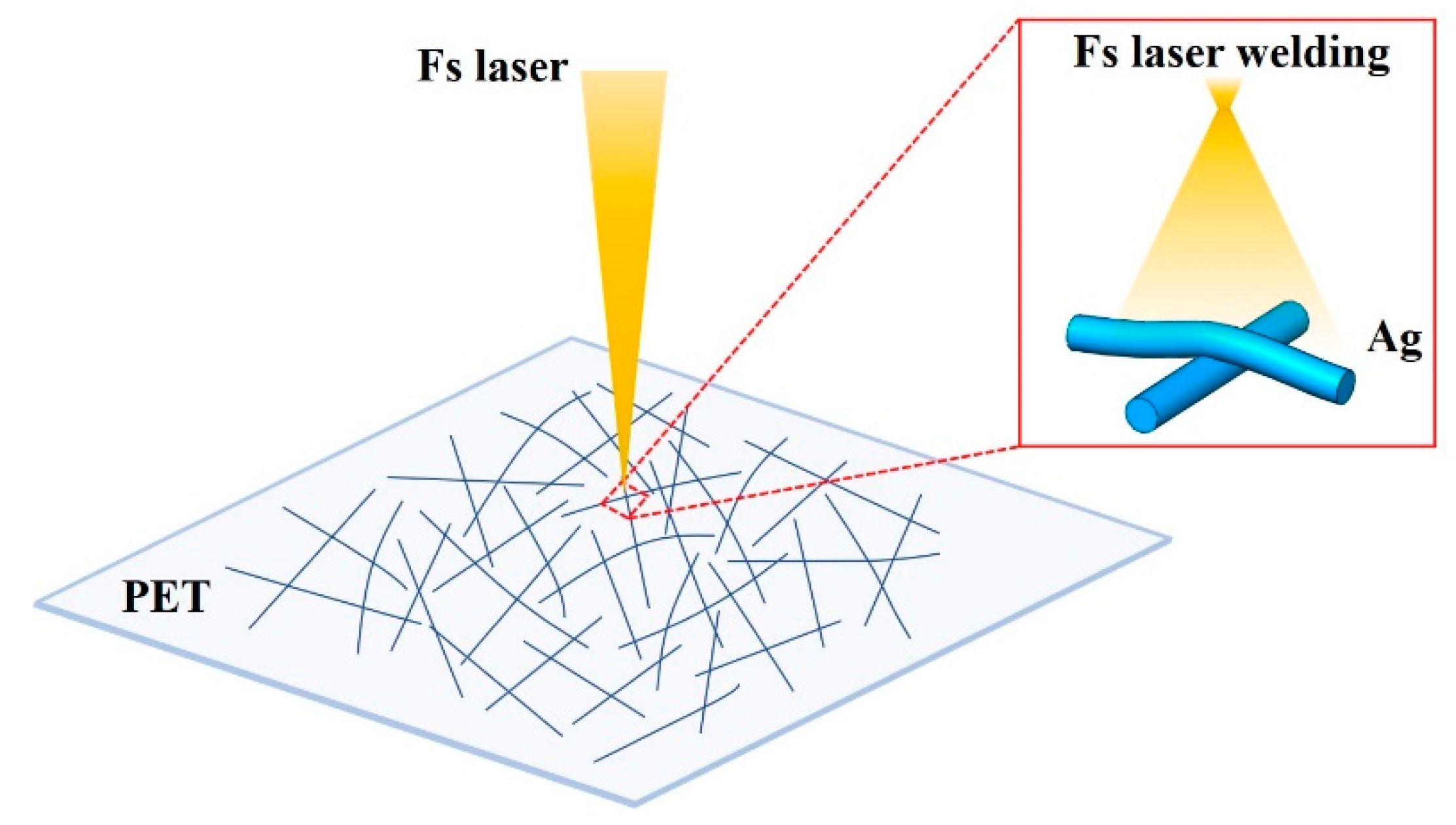

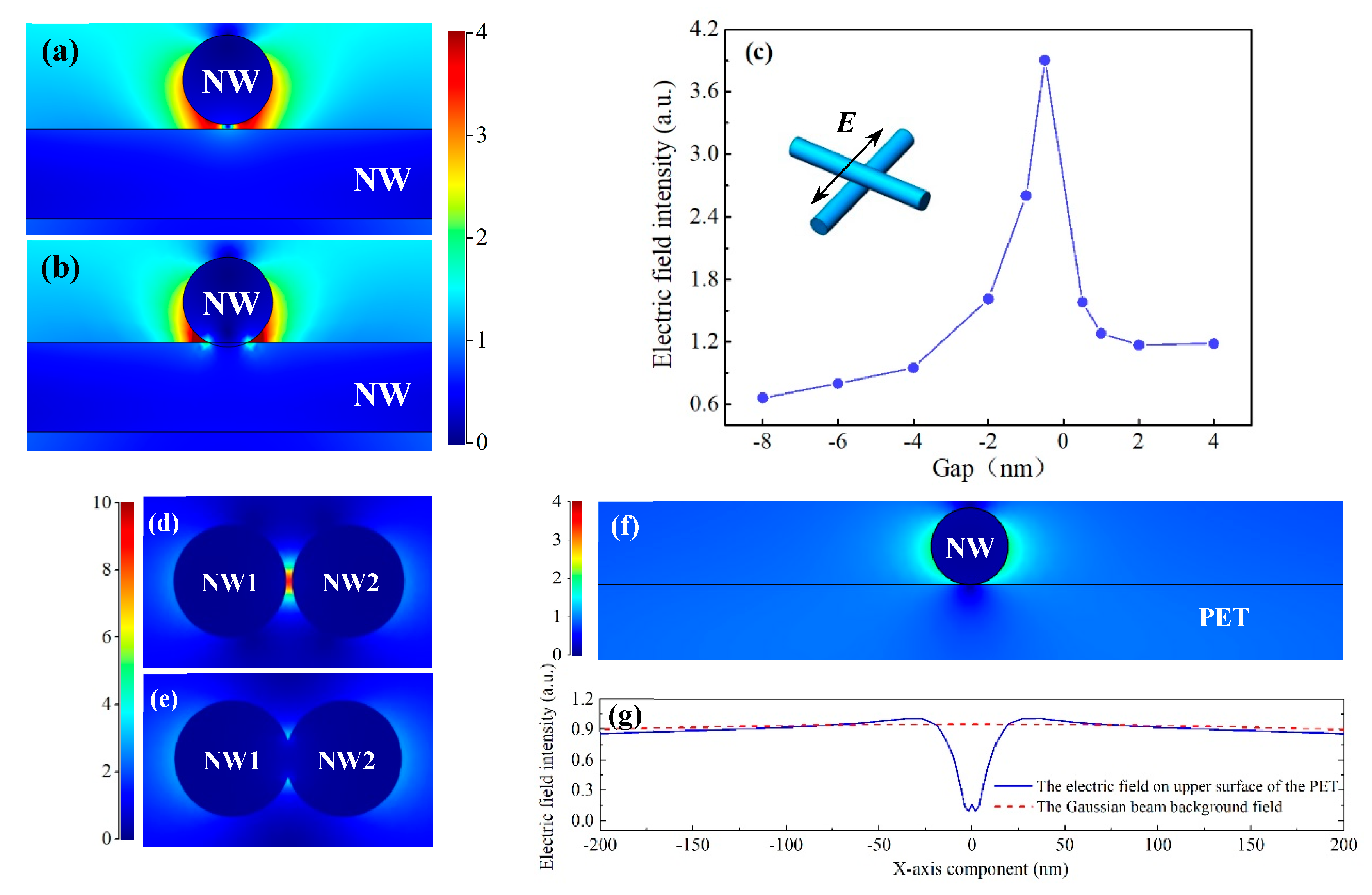
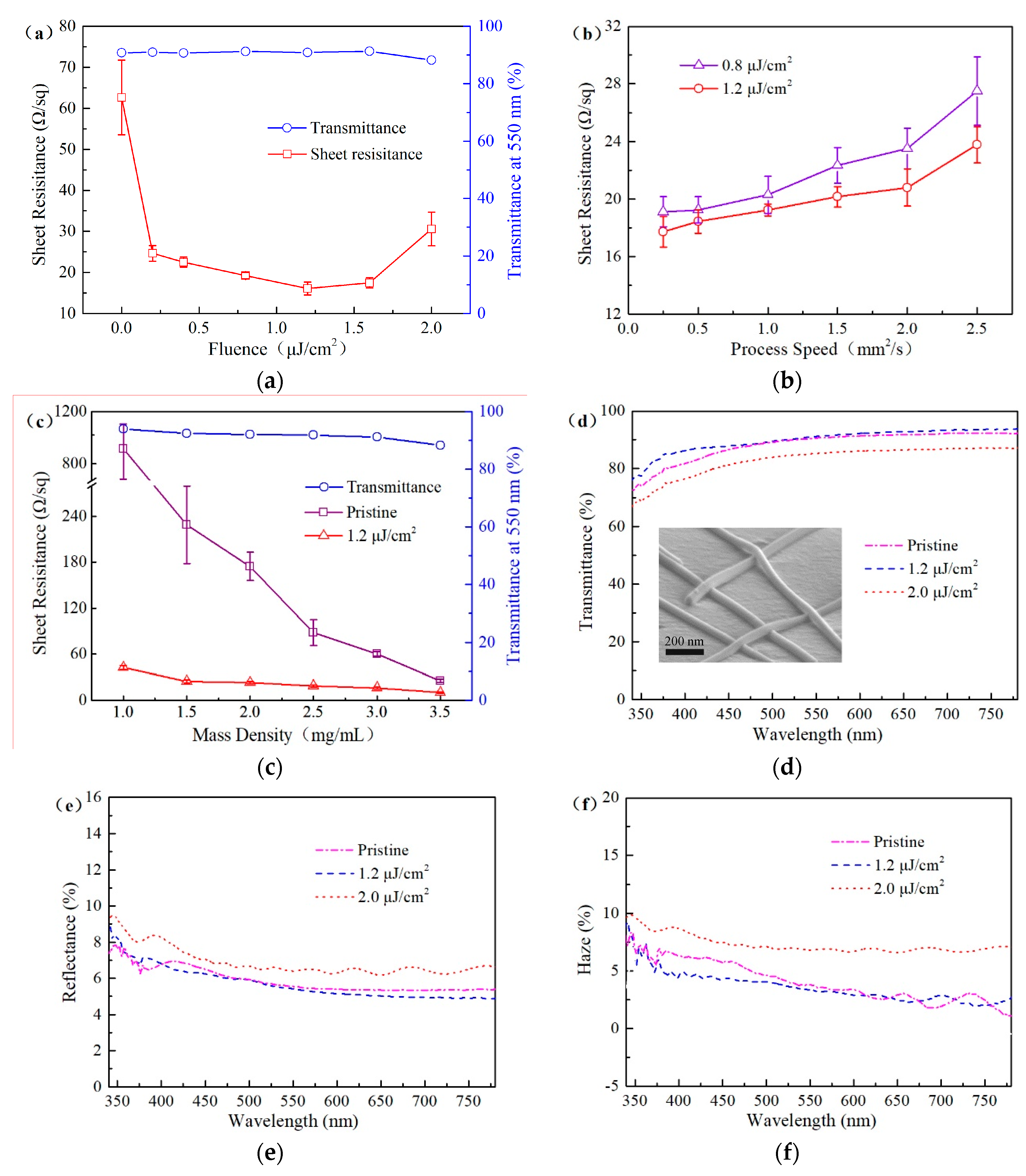
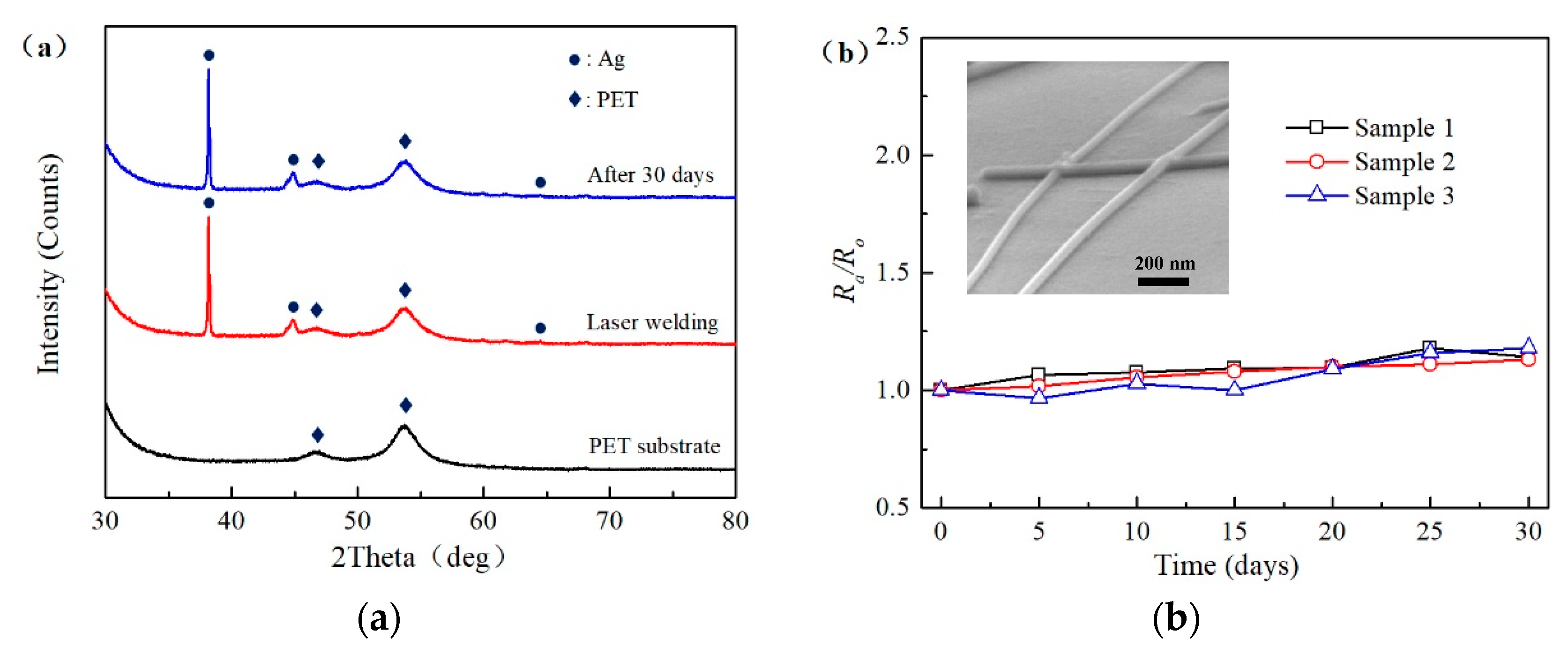
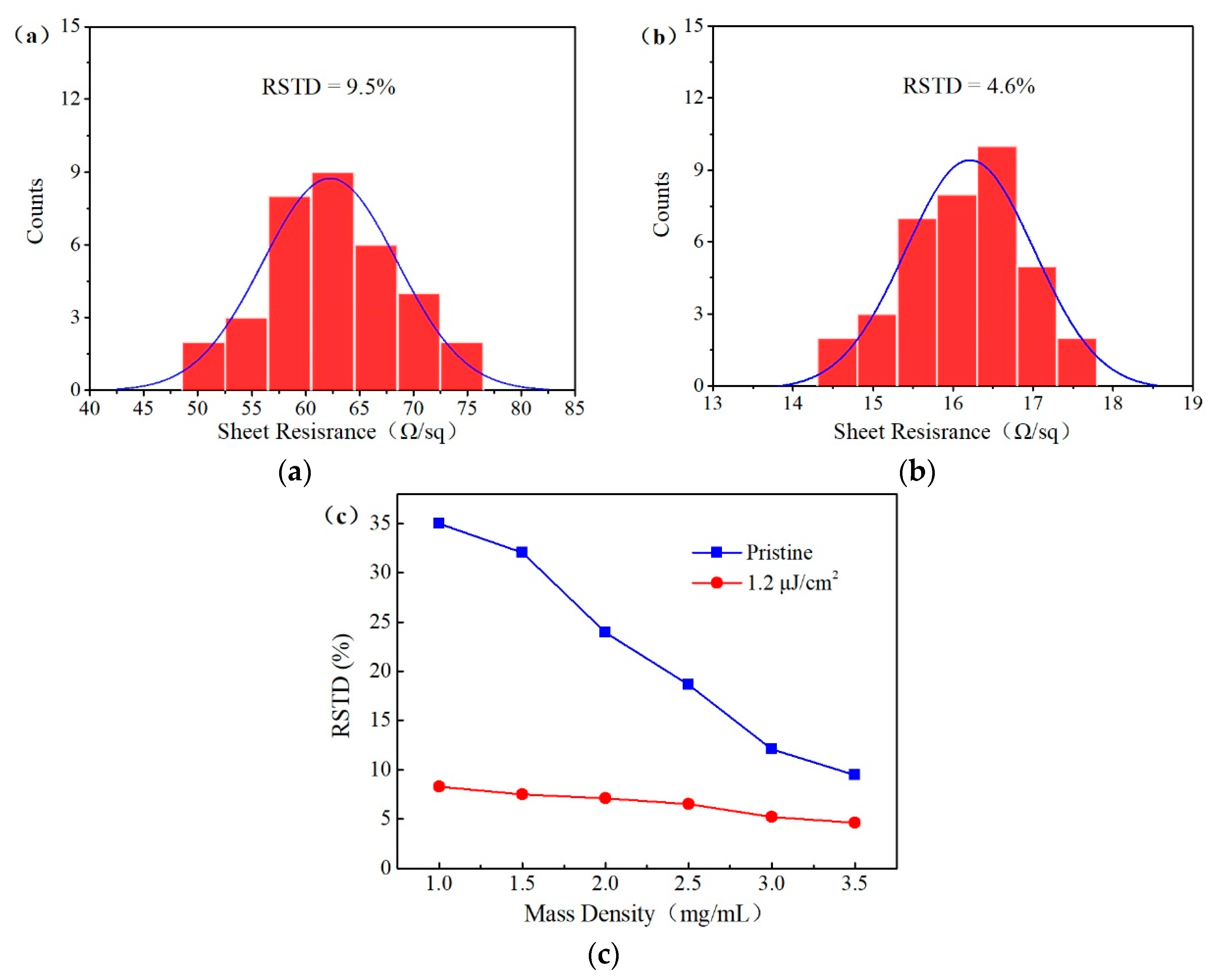
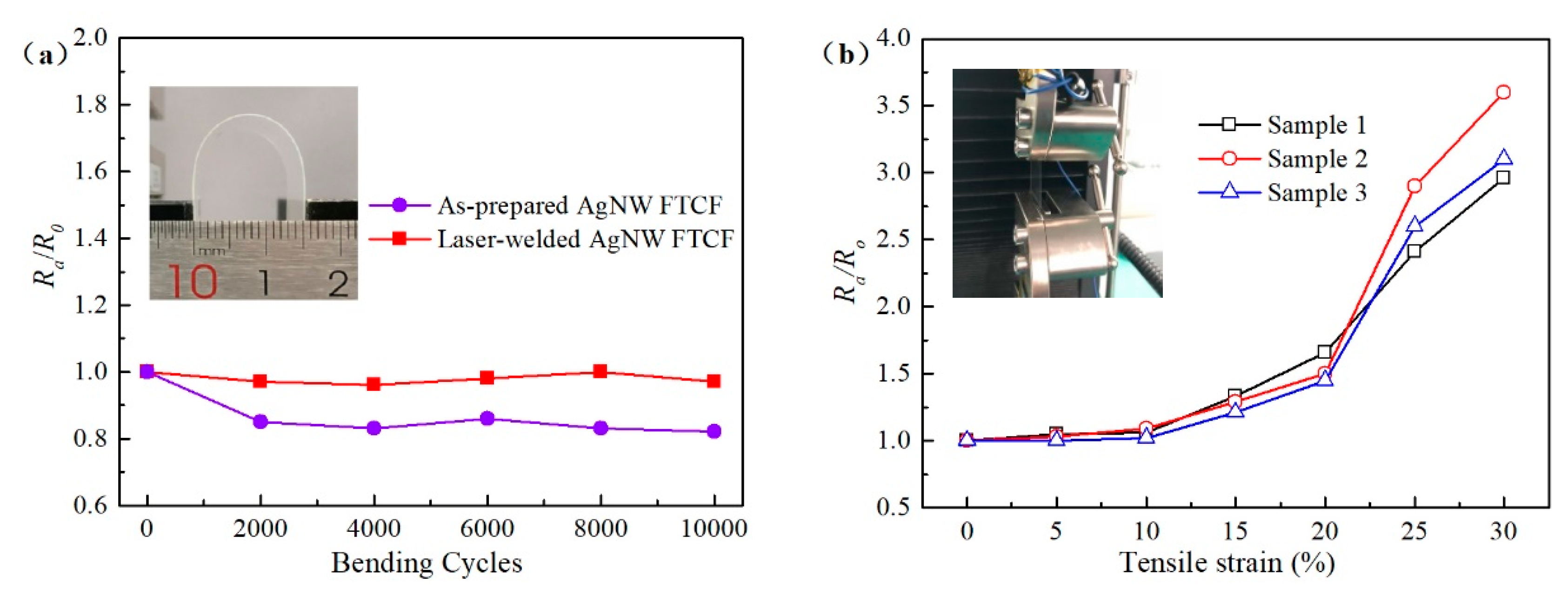
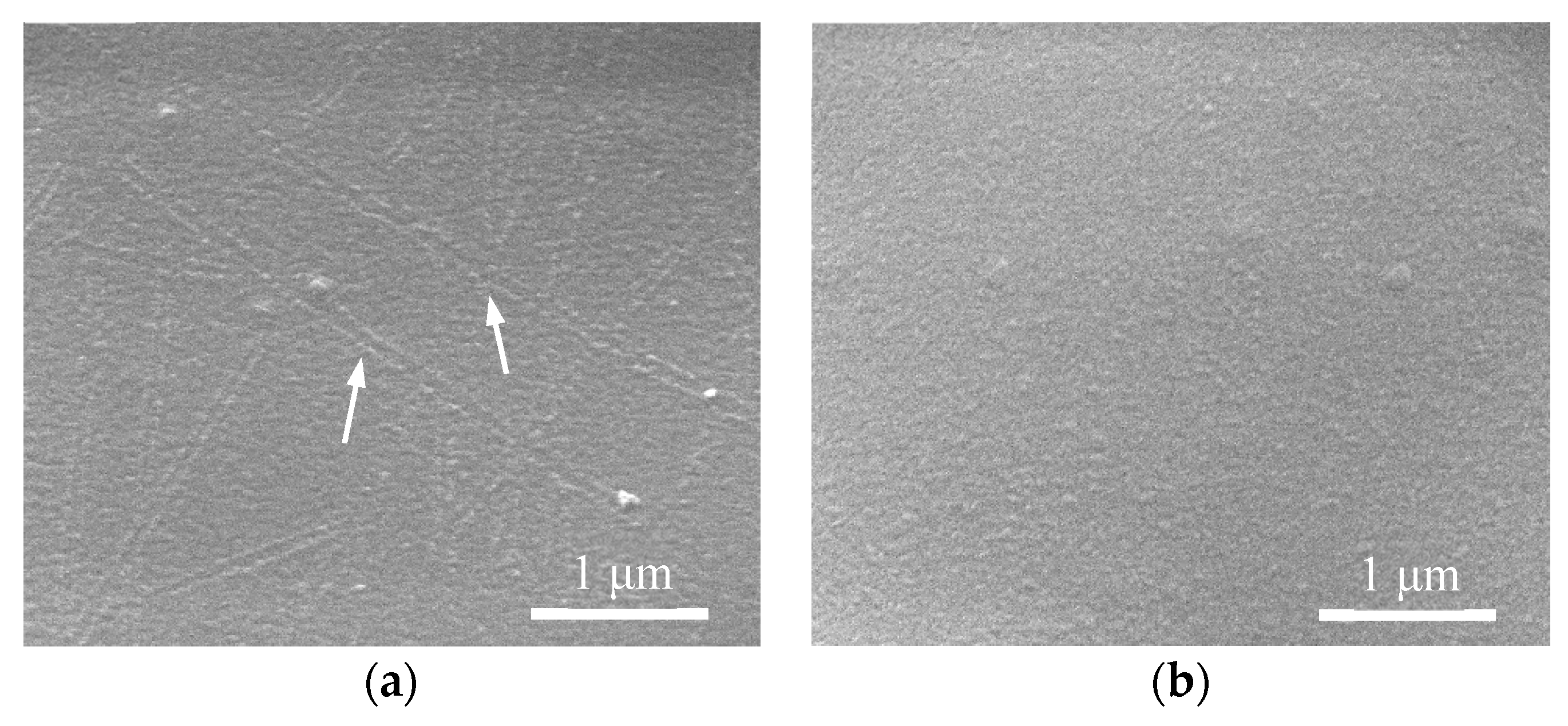
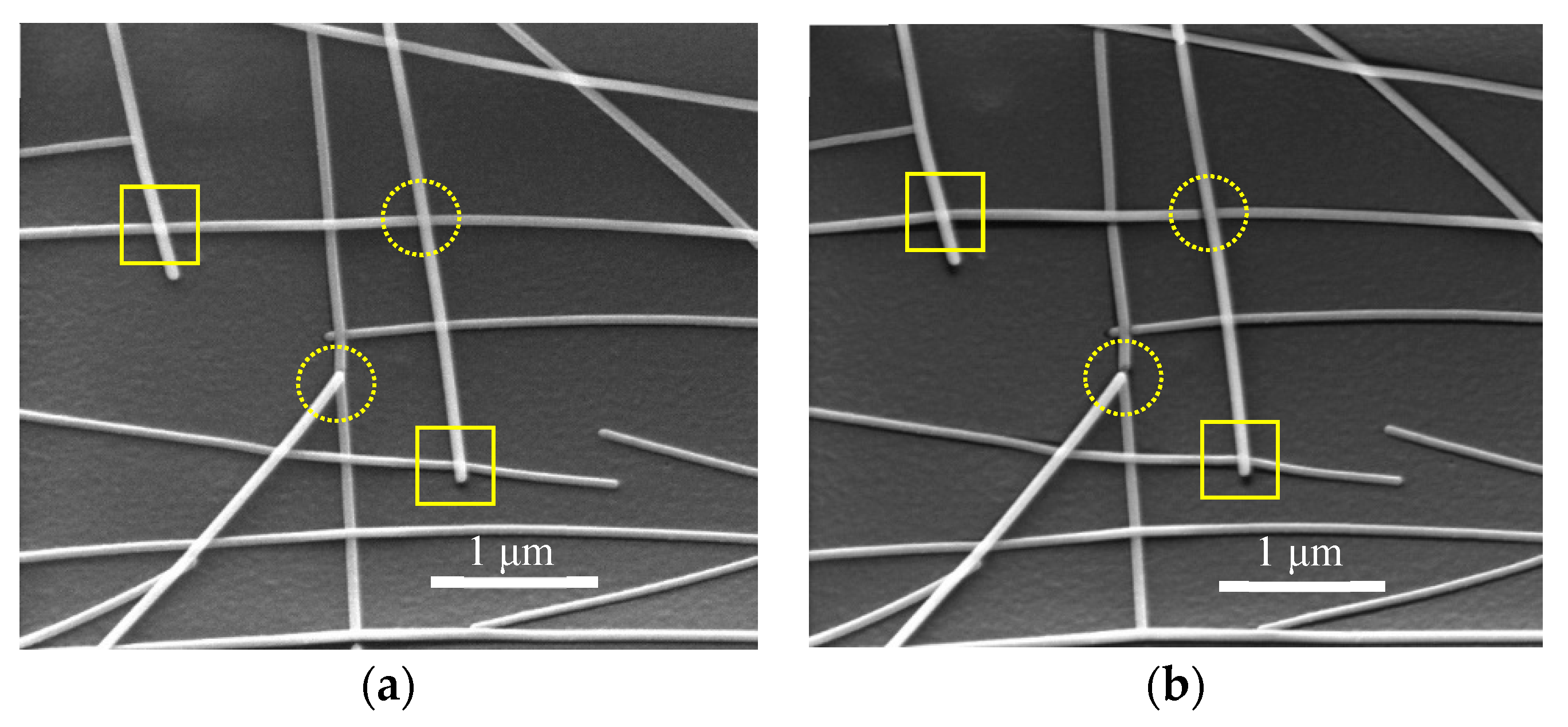
© 2019 by the authors. Licensee MDPI, Basel, Switzerland. This article is an open access article distributed under the terms and conditions of the Creative Commons Attribution (CC BY) license (http://creativecommons.org/licenses/by/4.0/).
Share and Cite
Hu, Y.; Liang, C.; Sun, X.; Zheng, J.; Duan, J.; Zhuang, X. Enhancement of the Conductivity and Uniformity of Silver Nanowire Flexible Transparent Conductive Films by Femtosecond Laser-Induced Nanowelding. Nanomaterials 2019, 9, 673. https://doi.org/10.3390/nano9050673
Hu Y, Liang C, Sun X, Zheng J, Duan J, Zhuang X. Enhancement of the Conductivity and Uniformity of Silver Nanowire Flexible Transparent Conductive Films by Femtosecond Laser-Induced Nanowelding. Nanomaterials. 2019; 9(5):673. https://doi.org/10.3390/nano9050673
Chicago/Turabian StyleHu, Youwang, Chang Liang, Xiaoyan Sun, Jianfen Zheng, Ji’an Duan, and Xuye Zhuang. 2019. "Enhancement of the Conductivity and Uniformity of Silver Nanowire Flexible Transparent Conductive Films by Femtosecond Laser-Induced Nanowelding" Nanomaterials 9, no. 5: 673. https://doi.org/10.3390/nano9050673
APA StyleHu, Y., Liang, C., Sun, X., Zheng, J., Duan, J., & Zhuang, X. (2019). Enhancement of the Conductivity and Uniformity of Silver Nanowire Flexible Transparent Conductive Films by Femtosecond Laser-Induced Nanowelding. Nanomaterials, 9(5), 673. https://doi.org/10.3390/nano9050673



